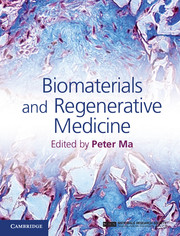Book contents
- Frontmatter
- Contents
- List of contributors
- Preface
- Part I Introduction to stem cells and regenerative medicine
- Part II Porous scaffolds for regenerative medicine
- 7 Nanofibrous polymer scaffolds with designed pore structure for regeneration
- 8 Electrospun micro/nanofibrous scaffolds
- 9 Biological scaffolds for regenerative medicine
- 10 Bioceramic scaffolds
- 11 Collagen-based tissue repair composite
- 12 Polymer/ceramic composite scaffolds for tissue regeneration
- 13 Computer-aided tissue engineering for modeling and fabrication of three-dimensional tissue scaffolds
- Part III Hydrogel scaffolds for regenerative medicine
- Part IV Biological factor delivery
- Part V Animal models and clinical applications
- Index
- References
7 - Nanofibrous polymer scaffolds with designed pore structure for regeneration
from Part II - Porous scaffolds for regenerative medicine
Published online by Cambridge University Press: 05 February 2015
- Frontmatter
- Contents
- List of contributors
- Preface
- Part I Introduction to stem cells and regenerative medicine
- Part II Porous scaffolds for regenerative medicine
- 7 Nanofibrous polymer scaffolds with designed pore structure for regeneration
- 8 Electrospun micro/nanofibrous scaffolds
- 9 Biological scaffolds for regenerative medicine
- 10 Bioceramic scaffolds
- 11 Collagen-based tissue repair composite
- 12 Polymer/ceramic composite scaffolds for tissue regeneration
- 13 Computer-aided tissue engineering for modeling and fabrication of three-dimensional tissue scaffolds
- Part III Hydrogel scaffolds for regenerative medicine
- Part IV Biological factor delivery
- Part V Animal models and clinical applications
- Index
- References
Summary
Introduction
Organ failure and tissue loss are challenging health issues due to the widespread occurrence of injuries, the lack of donated organs for transplantation, and the limitations of conventional artificial implants. The field of tissue engineering and regenerative medicine emerged to solve these issues by providing biological alternatives that restore, maintain, or improve tissue function for harvested tissues and organs [1–5]. In a typical tissue engineering approach, cells are grown in a three-dimensional (3D) biodegradable scaffold, which, ideally, should perform the structural and biochemical functions of the natural extracellular matrix (ECM), providing cells with topological and chemical cues as well as mechanical support until the cell-produced ECM takes over. Therefore, there is a set of key characteristics that the scaffold should have. First, adequate space or porosity with high interconnectivity is needed throughout the 3D scaffold in order to allow cell adhesion, migration, proliferation, and differentiation into the desired cell phenotypes for new tissue formation [6, 7]. A porous structure not only defines the initial void space available for cell seeding/ingrowth and new tissue formation, but also determines the mass transport pathways. Second, appropriate surface architecture is critical since this is where the cell–matrix interactions occur. In connective tissues, such as bone, skin, ligament, and tendon, the ECM consists primarily of proteoglycans and fibrous proteins, such as collagen. The fibrous architecture of collagen contributes to the mechanical stabilities of the ECM, and plays a vital role in cell attachment, proliferation, and differentiation [8]. Type I collagen is the most abundant type of collagen and forms nanofiber bundles with fiber diameter ranging from 50 to 500 nm. A nanofibrous (NF) surface is desired to mimic the natural ECM and is found to be advantageous in improving cell attachment, migration, proliferation, and differentiation [9]. Therefore, polymeric scaffolds with porous structure at the micrometer scale and fibrous architecture at the nanometer dimension should be promising candidates for tissue regeneration. Although it is not the focus of this chapter, chemical and biological functionalization of scaffolds can enhance cell–biomaterial interactions [10].
- Type
- Chapter
- Information
- Biomaterials and Regenerative Medicine , pp. 91 - 103Publisher: Cambridge University PressPrint publication year: 2014



